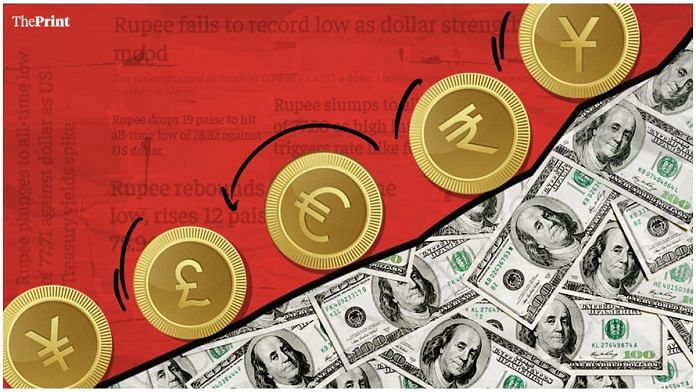When P Chidambaram was finance minister, among the things that used to provoke the famously thin-skinned politician were newspaper headlines that said “Rupee falls to a new low”. Or to a “record low”.
While he saw a falling currency as a reflection on his performance, he had a point about the headlines: If a generally weak currency like the rupee is falling, every fall (even if by a few paise) could be to a “record low”. Both the headlines and the minister’s response betrayed a mental bias against a weak currency. Indeed, the currency’s fall gets more attention than its rise.
Why is this history relevant? Because the headlines once again talk of the rupee falling to “new lows” against the US dollar. What the newspapers don’t say (but which Nirmala Sitharaman pointed out on Thursday) is that almost all currencies are falling against the dollar, and the rupee has fallen less than most — 6 per cent in the first half of 2022.
Compared to that, the euro has fallen by 11.6 per cent, the yen by 19.2 per cent, and the pound by 13.2 per cent. China’s yuan has fallen less (3.6 per cent), but the currencies of Australia, South Korea, and of course Pakistan have fallen more. A more accurate headline should therefore be that the rupee has moved up against almost all currencies. But that news is missing.
Should it matter? The answer is yes, because it pushes policy in the wrong direction. The Narendra Modi government, for instance, came into office with a bias in favour of a “strong currency” policy.
Also Read: How would India fare on a ‘modified’ misery index? Better than US & UK, worse than most others
What the framers of such policy ignore is that almost every country with a successful long-term record of development (Japan and China being among the best examples) has pursued a “weak currency” policy in order to win export markets. The reason is simple: If you are competing primarily on price, because at your stage of development you can’t compete on technology or product quality, a weak currency helps. Over time, as exports gain momentum and the economy achieves external viability, the currency reverses its decline.
Too many people tend to get wrong this long-term cause-and-effect relationship between country and currency. A strengthening economy gets a strengthening currency, helped along by capital flows. The causation is not the other way round: A weak economy, or one with high inflation, does not become strong if you artificially boost its currency, or keep it pegged too high. Such a policy would not be sustainable, and would risk capital flowing out.
As for trade, over more than four decades (including the years of Nehru’s atmanirbharta), India kept the rupee over-valued. So while countries in East Asia boosted their trade, India’s share of the global total collapsed by 80 per cent — from about 2.5 per cent in 1947 to about 0.5 per cent.
Two contrasting comparisons should drive the point home. The Indian rupee has been stronger than its Pakistan counterpart (now 205 to the dollar) because Pakistan’s economy has been thoroughly mismanaged. At the other end of the scale, the Thai baht once traded at a 10 per cent premium to the rupee but is now worth about ~2.20.
Even with a stronger currency, Thailand continues to sustain its annual trade surplus. India’s trade and inflation record improved after its currency and other policies became more market-oriented in and after 1991, yet it has run a trade deficit in most years despite the rupee’s continuous fall. Clearly, the reform done so far is not enough.
If India’s politicians want a stronger rupee, they need to do a better job of managing the economy: Inflation control, productivity improvement, etc. Getting the Reserve Bank to spend billions of dollars to boost the rupee is the wrong way to go.
The fact is that, except very recently, inflation has been higher in India than in its important markets. It is but natural that this loss in the rupee’s domestic purchasing power should get reflected in a lower exchange rate. Change the performance metrics, and the rupee will hold its own without the Reserve Bank having to intervene.
By special arrangement with Business Standard
Also Read: For India, economic disorder is a reality to be reckoned with, but it also presents an opportunity






